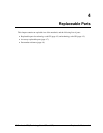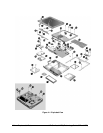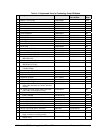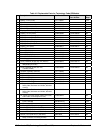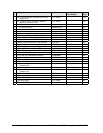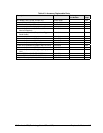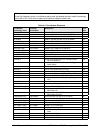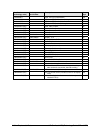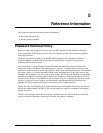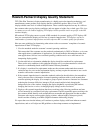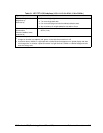
5-2 Reference Information HP Omnibook XE3 (Technology Codes GE and GD)
Hewlett-Packard Display Quality Statement
TFT (Thin Film Transistor) display manufacturing is a highly precise but imperfect technology, and
manufacturers cannot produce large displays that are cosmetically perfect. Most, if not all, TFT
displays exhibit some level of cosmetic imperfection. These cosmetic imperfections may be visible to
the customer under varying display conditions, and can appear as bright, dim, or dark spots.
This issue
is common across all vendors supplying TFT displays in their products and is not specific to the HP
notebook display.
HP notebook TFT displays meet or exceed all HP standards for cosmetic quality of TFT displays. HP
does not warrant that the displays will be free of cosmetic imperfections.
TFT displays can have a
small number of cosmetic imperfections and still conform to HP’s cosmetic quality specifications.
Here are some guidelines for determining what action to take on customers’ complaints of cosmetic
imperfections in their TFT displays:
1.
View the notebook under the customer’s normal operating conditions.
This means that if the customer uses the notebook predominately in DOS, in Windows, or in some
other application or combination of applications, you should make the determination under those
same applications. Self test is not a normal operating condition and is not a sufficient tool for
interpreting display quality.
2.
Use the table below to determine whether the display should be considered for replacement.
These are the only conditions in this guideline that may call for a replacement due to a defect in
material or workmanship based on the HP Limited Warranty Statement.
3.
If a display is considered for replacement, make sure the customer understands that cosmetic
variations may also exist on the replacement display, and may require the customer to use a work-
around to obscure the cosmetic imperfection.
4.
If the cosmetic imperfection
does
meet the standards outlined in the table below, but nonetheless
clearly obscures data or information in normal operating conditions with no work-around, then
consider replacing the display. (For example: a group of pixels obscures a character in a document
rendering the character difficult to interpret.) Work-arounds might include changing the
background color of the window; changing the display brightness; repositioning the window;
changing the font size or color, or changing display settings such as resolution.
5.
Displays with cosmetic imperfections that do not conform to the following conditions and tests
will not normally be considered for display replacement. The HP-responsible person working with
the customer should identify work-arounds that are reasonable and appropriate for that customer.
Customers who require a more perfect display solution, without bright or dim spots (pixels)
should consider switching to an HPA (High-Performance Addressing) display.
We expect that over time the industry will continue to produce displays with fewer inherent cosmetic
imperfections, and we will adjust our HP guidelines as these improvements are implemented.



